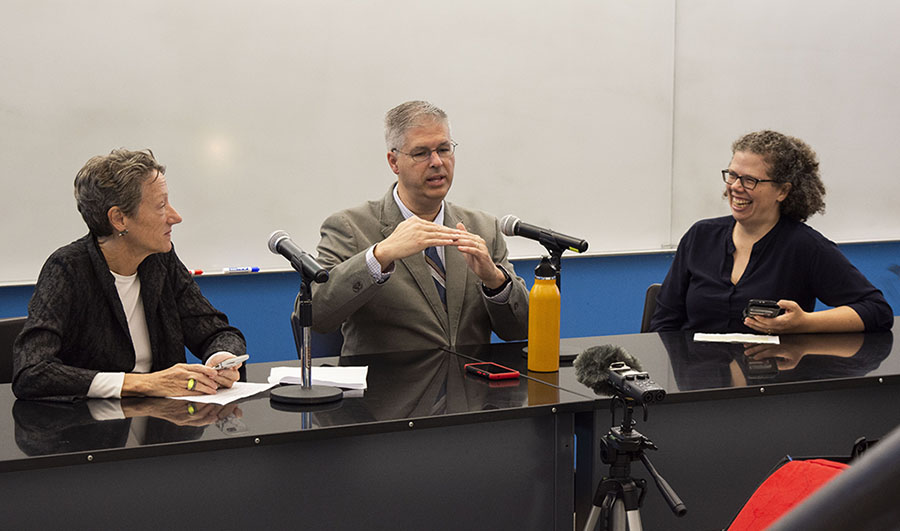
|
|
| Left to right: Professor Ellen Dunham-Jones, Strong Towns President Chuck Marohn and Associate Professor Kari Watkins discuss urban design and transportation. Photo by Carmen Wagster. |
As new roads and buildings pop up in communities around the country, Chuck Marohn believes that the way that the United States is—and has been—developing for decades is actually largely counterproductive.
Marohn is the founder and president of Strong Towns, an organization dedicated to creating more resilient communities through strategic growth. Marohn visited Georgia Tech for a conversation about the future of urban design and transportation hosted by professors Ellen Dunham-Jones and Kari Watkins.
The Oct. 4 event was part of REDESIGNING CITIES: The Speedwell Foundation Talks at Georgia Tech, hosted by Dunham-Jones and sponsored by Jenny and Mike Messner, CE 76. The series featuresprominent speakers on topics related to outdated infrastructure, disruptive technologies, social capital, equity and climate change.
Mahron, an engineer and planner who spent much of his career working with governments, started his organization about 10 years ago after realizing that the decisions being made around growth and development weren’t sustainable long-term.
“We feel a disconnect between our current development pattern and the way we live, and a desire to see these places become better,” Marohn said.
The development that Marohn refers to is the kind of suburban development that extends out from existing towns and cities—what he describes as “kinetic.”
This development pattern has its roots in post-WWII America, when the country entered into a growth economy that fueled a spate of new homes and infrastructure. This strategy was successful for a while, and many of our models and discussions about growth come from the 1950s and 60s.
Much of this thinking is now outdated, but it’s easy to see how this pattern came to be. New development provides cities and counties with a quick spike of cash: permitting and construction fees, followed by property and sales taxes—all of which make new development enticing.
A government’s expenses are low for many years because all the sidewalks, pipes and other infrastructure are brand new. But over time, that infrastructure requires maintenance or replacement, the cost of which eclipses the initial profit. To pay for the maintenance, cities must raise additional cash through new growth—creating an unsustainable cycle.
As an engineer and planner, Marohn also began to take issue with what he described as the “cognitive dissonance” often present during the financial analysis of road construction or improvement. The viability of a new road would be based on travel times and speeding up traffic. Meanwhile, the costs would be justified from an economic development angle by adding gas stations, restaurants or stores along the road, all of which slow traffic down.
“We’re trying to move people over distance, and we’re trying to build wealth. Those are two very competing objectives,” Marohn says. “When we mix the two, you get this deadly combination of really expensive infrastructure with very low financial trends, very poor access, but also very poor mobility.”
The solution, Marohn believes, is to separate transportation from economic development and focus on building prosperity, long-term stability and a sense of place within communities.
Like Marohn, Watkins and Dunham-Jones are devoted to finding ways to build more resilient, sustainable and healthy communities.
Dunham-Jones is a professor and director of the master of science in urban design program in the School of Architecture at Georgia Tech. She is also a leading urbanist and an authority on suburban redevelopment.
Watkins, CE 97, is the Frederick Law Olmsted Associate Professor in the School of Civil and Environmental Engineering. Her teaching and research revolve around multi-modal transportation planning and the use of technology in transportation.
Through their work in urban design and engineering, they are creating forward-looking curricula at Georgia Tech and informing the next generation of students to help change the conversation around future growth and development.
Marohn told the group of students that he believes as a society, it’s time to stop building big infrastructure.
“I think the challenge we face and really the challenge that you as students are going to inherit is not how can we build the next thing, but how do we go back and make good use of everything we have?” Marohn said.
His other advice to students was to understand and embrace human nature as they move into their careers.
“Cities are complex, adaptive environments. They're human ecosystems,” Marohn said. “We could easily fall into the idea that the humans are secondary to our genius design. And the reality is, the humans are central. And our designs and our things we do are essentially servants of their messiness and complexity.”

